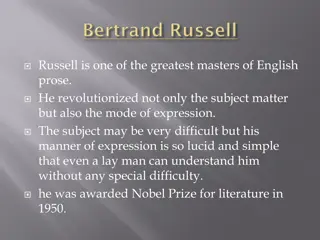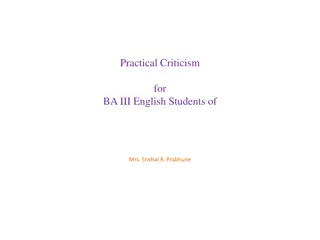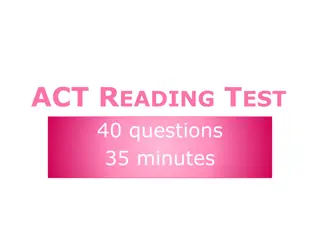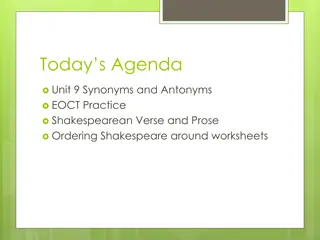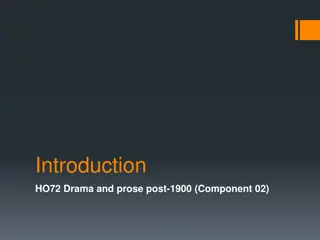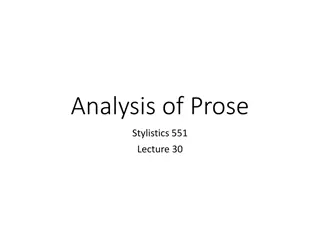Classic Principles for Clear Prose Writing
Discover timeless advice on writing well from Dr. Les Sillars, a Journalism Professor. Learn the key elements of good writing: grammar, clarity, organization, style, and unity. Explore examples illustrating the importance of clarity and concise expression in effective writing. Strengthen your writing skills by understanding the essence of simplicity and complexity in sentence structure.
Download Presentation

Please find below an Image/Link to download the presentation.
The content on the website is provided AS IS for your information and personal use only. It may not be sold, licensed, or shared on other websites without obtaining consent from the author.If you encounter any issues during the download, it is possible that the publisher has removed the file from their server.
You are allowed to download the files provided on this website for personal or commercial use, subject to the condition that they are used lawfully. All files are the property of their respective owners.
The content on the website is provided AS IS for your information and personal use only. It may not be sold, licensed, or shared on other websites without obtaining consent from the author.
E N D
Presentation Transcript
Sets Recall from chapter 22 that one of the Collection subclasses is the Set A Set is a list in which there are no duplicate entries, which you might recall from your math classes Set operations include isAnElementOf implemented by Collection s contains intersection implemented by Collection s retainAll union implemented by Collection s addAll difference implemented by Collection s removeAll subset we can implement this by seeing if the intersection of this set with another set equals this set superset we can implement this by seeing if the intersection of this set with another set equals the other set Since sets can be implemented using a Collection, why do we need a separate Set class?
Sets Continued The Set differs from the Collection because the Set cannot contain duplicate entries In addition, we will implement the Set (an abstract class) in one of three concrete classes HashSet LinkedHashSet TreeSet The HashSet and LinkedHashSet use a concept called hashing to determine the proper location to insert an item Thus, the Set stands apart from the Collection because of this idea of hashing Recall in an array implementation of a list, searching for an item can range from O(n) if the list is unordered to O(log n) in a sorted list With hashing, we can potentially decrease the complexity to O(1)!
Hashing Assume we have an array named list of n elements Given element k to insert, we determine its position through a hashing function list[hash(k)] = k That is, the function hash tells us where to insert the item k Now to retrieve some item x, we look for it at list[hash(x)] assuming the function is a mathematical function, we should have an insert, search and deletion complexity of O(1) that is, we locate the proper index without searching by just applying the function hash note that the function hash() does not guarantee that two data x1 and x2 will not yield the same response (that is, it is possible that hash(x1) == hash(x2) this leads to collisions which results in poorer complexity
Example Assume we have an array of 11 elements hash function: h(value) = value % 11 Key of 45 maps to 45%11 = 1 Key of 58 maps to 58%11 = 3 Key of 4 maps to 4%11 = 4 Key of 28 maps to 28%11 = 5 Key of 32 maps to 32%11 = 10 We want to insert 12 Key of 12 maps to 12%11 = 1 But this array location is already taken so we have a collision There are several forms of collision processing something you will see in 364 but not covered here
hashCode hashCode is a method implemented on Object and inherited to all classes The hashCode method is used by default as the hash function for the HashSet and LinkedHashSet classes hashCode is implemented to return the memory location of the object unless overridden in a specific class See section 28.3 (pages 999-1000) of the textbook for specific hash code implementations for the primitive types and Strings Below is a randomly generated set of Strings and the values returned by hashCode on each String mmq u nzqjsklriqbuak quvmhgdyckdiks uvzx 108241 117 -1802842392 -818734588 3602847 ulydocdjyekfnremd enifinzvsppoqafocb hzju jbraawv jocxx 1333866165 -1195120645 3218909 -1794932679 101299006
Set Subclasses Set is an interface that implements the Collection interface The implementation for inserting an element must ensure that the new element does not already exist in the elements already in the Set using equals as in !e1.equals(e2) is false for all e1, e2 in the Set Set has a subclass interface called SortedSet The class AbstractSet extends AbstractCollection and implements Set but is itself an abstract class as it does not implement the size or iterator methods There are two subclasses of AbstractSet which are concrete classes: TreeSet (which implements SortedSet) and HashSet HashSet has a child class of LinkedHashSet
interface java.util.Collection<E> The Set Subhierarchy interface java.util.Set<E> java.util.AbstractSet<E> interface java.util.SortedSet<E> +first(): E +last(): E +headSet(toElement: E): SortedSet<E> +tailSet(fromElement: E): SortedSet<E> The object type E must implement the method hashCode java.util.HashSet<E> +HashSet() +HashSet(c: Collection<? extends E>) +HashSet(initialCapacity: int) +HashSet(initialCapacity: int, loadFactor: float) This method should attempt to place new elements in unique locations to reduce collisions interface java.util.NavigableSet<E> +pollFirst(): E +pollLast(): E +lower(e: E): E +higher(e: E):E +floor(e: E): E +ceiling(e: E): E java.util.LinkedHashSet<E> +LinkedHashSet() +LinkedHashSet(c: Collection<? extends E>) +LinkedHashSet(initialCapacity: int) +LinkedHashSet(initialCapacity: int, loadFactor: float) If E e1 and E e2 are equal then they will return the same hash code value, if they are not equal they may still return the same hash code but hopefully not java.util.TreeSet<E> +TreeSet() +TreeSet(c: Collection<? extends E>) +TreeSet(comparator: Comparator<? super E>) +TreeSet(s: SortedSet<E>)
HashSet vs LinkedHashSet vs TreeSet As we saw with the previous hashing example, the items placed into the data structure will not be in order Not in sequential order of insertion Not in numerical/alphabetical order of the keys The LinkedHashSet implementation permits two different views of the data The order as dictated by the hash function The order that the items were inserted The LinkedHashSet implements hashing using a linked structure that maintains the original insertion order The TreeSet implementation permits two different views of the data as well The order as dictated by the hash function The order as dictated by Comparable and/or Comparator so that the type of datum being stored must implement these
More Notice that Collection implements Iterable so that we can step through the items in a Set but the order of iteration will be based on where they are stored, not the order that they were entered You might recall that we can iterate through a Collection using an Iterator (e.g., Iterator<type> it=set.iterator( );) or by using an iterator for loop (for each loop) But Set does not implement the get method, unlike lists, so we could not iterate through a Set using a counting for loop and set.get(i); The TreeSet has a number of additional methods available first( ) and last( ) to return the first and last elements inserted into the TreeSet and pollFirst/pollLast to remove and return the first and last elements headSet(e) and tailSet(e) to return all elements < e or >= e respectively lower(e)/floor(e) return the next element < e or <=e ceiling(e)/higher(e) return the next elements > e or >= e
HashSet<String> set=new HashSet<>(); set.add("Frank"); set.add("Gail"); set.add("Ruth"); set.add("Ian"); set.add("Motorhead"); set.add("Dweezil"); set.add("Ike"); set.add("Napolean"); HashSet<String> set2=new HashSet<>(); set2.addAll(set); set2.remove("Frank"); set2.remove("Gail"); System.out.println("Does set 2 contain Motorhead?" + set2.contains("Motorhead")); System.out.println("Does set 2 contain Gail?" + set2.contains("Gail")); HashSet<String> set3=new HashSet<>(); set3.add("Gail"); set3.add("Ian"); set3.add("Ray"); set3.add("Dweezil"); set3.add("Sheila"); set3.retainAll(set2); System.out.println("Set 2 intersection set 3 = " + set3); Example 1: HashSet Output: Does set 2 contain Motorhead?true Does set 2 contain Gail?false Set 2 intersection set 3 = [Ian, Dweezil]
Example 2: Iterating Through a Set LinkedHashSet<String> set = new LinkedHashSet<>(); set.add("Frank"); set.add("Gail"); set.add("Ruth"); set.add("Ian"); set.add("Motorhead"); set.add("Dweezil"); set.add("Ike"); set.add("Napolean"); for(String s:set) System.out.println(s); HashSet<String> set = new HashSet<>(); set.add("Frank"); set.add("Gail"); set.add("Ruth"); set.add("Ian"); set.add("Motorhead"); set.add("Dweezil"); set.add("Ike"); set.add("Napolean"); for(String s:set) System.out.println(s); Frank Gail Ruth Ian Motorhead Dweezil Ike Napolean Motorhead Frank Gail Ian Ike Dweezil Napolean Ruth Notice how the output differs!
Example 3: TreeSet TreeSet<String> set=new TreeSet<>(); set.add("Frank"); set.add("Gail"); set.add("Ruth"); set.add("Ian"); set.add("Motorhead"); set.add("Dweezil"); set.add("Ike"); set.add("Napolean"); System.out.println(set.headSet("Ian")); System.out.println(set.ceiling("I")); System.out.println(set.pollLast()); System.out.println(set); Notice how the output is in sorted order, not in order entered or based on a hashing order [Dweezil, Frank, Gail] Ian Ruth [Dweezil, Frank, Gail, Ian, Ike, Motorhead, Napolean]
Using HashSet Here, we generate 1000 random numbers between 0 and 999 and contain the number of times a random number has already been generated We could use a boolean array[1000] to store whether a value has already been generated but this is easier HashSet<Integer> set=new HashSet<>(1000); Random g=new Random(); int j, count=0,size=1000; // change size to experiment Integer temp; for(int i=0;i<size;i++) { j=g.nextInt(size); temp=new Integer(j); if(set.contains(temp)) count++; else set.add(new Integer(i)); } System.out.println("Out of 1000 random ints from 0-999, " + count + " were duplicated"); For size=1000, number of duplicates is usually around 375
Efficiency Sets can be more efficient when inserting, deleting and searching than ordered or unordered lists The complexities of these operations are O(1) hashing (average case, worst case is as bad as O(n)) O(log n)/O(n) ordered list search/insert and delete (worst case) O(n) unordered list (worst case) The book presents some statistics on page 840 where we see that the HashSet, LinkedHashSet and TreeSet all outperform the ArrayList and LinkedList One mitigating factor is the size of the Set but we can establish the size of the Set in the constructor along with the loadFactor The loadFactor is the percentage that the structure can be full before the structure is enlarged A reasonable load factor is 75% (this is the default for all 3 Set subclasses)
Maps The Map is a data structure similar to a HashSet in that it stores values based on a key But in the case of a Map, it stores both the key and the value The key is used to determine where the item should be placed (or where to find it) that is, the key maps to where the value is stored Keys can be any type of Object Like a Set, a Map cannot contain duplicate Key entries (but it can contain duplicate Value entries) The Map class is an interface with a subclass interface Sorted Map An abstract class AbstractMap, implements all of the Map interface except for one method (entrySet) There are 3 concrete Map classes: Tree Map (subclass of AbstractMap and implements SortedMap), HashMap and LinkedHashMap
The Map Class java.util.Map<K, V> +clear(): void +containsKey(key: Object): boolean Removes all mappings from this map. Returns true if this map contains a mapping for the specified key. Returns true if this map maps one or more keys to the specified value. Returns a set consisting of the entries in this map. Returns the value for the specified key in this map. Returns true if this map contains no mappings. Returns a set consisting of the keys in this map. Puts a mapping in this map. Adds all the mappings from m to this map. Removes the mapping for the specified key. Returns the number of mappings in this map. Returns a collection consisting of the values in this map. +containsValue(value: Object): boolean +entrySet(): Set +get(key: Object): V +isEmpty(): boolean +keySet(): Set<K> +put(key: K, value: V): V +putAll(m: Map): void +remove(key: Object): V +size(): int +values(): Collection<V> You primarily insert new Key/Value pairs (using put), or copy another Map (using putAll) or remove a value using remove(key) or retrieve a value using get(key)
interface java.util.Map<K, V> interface Map java.util.AbstractMap<K, V> java.util.SortedMap<K, V> +firstKey(): K +lastKey(): K +comparator(): Comparator<? super K>) +headMap(toKey: K): SortedMap +tailMap(fromKey: K): SortedMap Subhierarchy java.util.HashMap<K, V> +HashMap() +HashMap(m: Map) java.util.LinkedHashMap<K, V> java.util.TreeMap<K, V> +TreeMap() +TreeMap(m: Map) +TreeMap(c: Comparator<? super K>) +LinkedHashMap() +LinkedHashMap(m: Map) +LinkedHashMap(initialCapacity: int, loadFactor: float, accessOrder: boolean) SortedMap TreeMap Map AbstractMap HashMap LinkedHashMap Concrete Classes Abstract Classes Interfaces
Comparison of Subtypes HashMap like the HashSet uses a hashing function to place the key/value pairs efficient for insert, delete and search LinkedHashMap like the LinkedHashSet uses a linked structure to store the original order of key/value entries this allows for sequential access of that ordering if needed TreeMap like the TreeSet uses Comparable/Comparator so that keys can be accessed in a sorted order allows for retrieving key/value pairs based on the ordering property of the keys (but not the values) contains extra methods such as firstKey, lastKey, headMap, tailMap, floorKey, ceilingKey, lowerKey, higherKey, pollFirstEntry and pollLastEntry (similar to TreeSet s first, last, headSet, tailSet, floor, ceiling, lower, higher, pollFirst and pollLast)
import java.util.*; public class CountOccurrenceOfWords { public static void main(String[] args) { String text = "; Map<String,Integer> map = new TreeMap<String,Integer>(); String[] words = text.split("[ \n\t\r.,;:!?(){}]"); for (int i = 0; i < words.length; i++) { String key = words[i].toLowerCase(); if (key.length() > 0) { if (!map.containsKey(key)) { map.put(key, 1); } else { int value = map.get(key); value++; map.put(key, value); } } } Set<Map.Entry<String, Integer>> entrySet = map.entrySet(); for (Map.Entry<String, Integer> entry: entrySet) System.out.println(entry.getKey()+" "+entry.getValue()); } } A similar version is on the website using a HashMap Example of TreeMap: Counting Words
try { Scanner in=new Scanner(new File("capitals.txt")); Scanner key=new Scanner(System.in); String city, state, user; HashMap<String,String> map=new HashMap<>(); while(in.hasNext()) { city=in.next(); state=in.next(); map.put(state,city); } System.out.print("Enter a state "); user=key.next(); while(!user.toLowerCase().equals("done")) { System.out.println(user+"'s capital is +map.get(user)); System.out.print("Enter a state "); user=key.next(); } } Map Example: State Capitals
Singleton and Immutable Collections Recall the Collections class contains static methods to implement operations on various Collection Objects Included in these methods are those that Create read-only sets, lists, maps Singleton sets, lists, maps (Collection objects that store only a single item) these structures are immutable so that once created, they can never have more elements added or the single elements removed Immutable sets, lists, maps (once created, cannot be changed) There are also constants available to create empty structures: EMPTY_SET, EMPTY_LIST, EMPTY_MAP Details for these methods are briefly given on pages 848- 849






